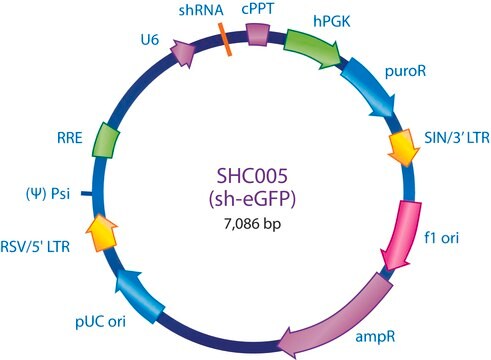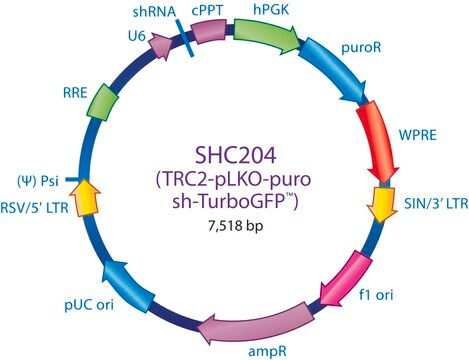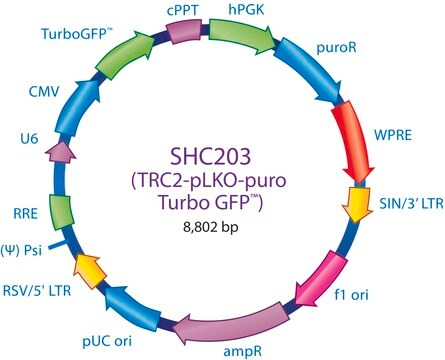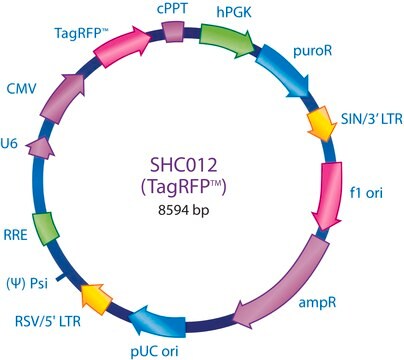SHC004
MISSION® pLKO.1-puro TurboGFP™ shRNA Control Plasmid DNA
shRNA sequence targeting tGFP
Synonym(s):
MISSION® Control Vectors
Sign Into View Organizational & Contract Pricing
All Photos(1)
About This Item
Recommended Products
Quality Level
product line
MISSION®
concentration
500 ng/μL in TE buffer; DNA (10μg of plasmid DNA)
shipped in
dry ice
storage temp.
−20°C
Looking for similar products? Visit Product Comparison Guide
General description
The MISSION TurboGFP shRNA Control Vector is a 7,087 base pair lentivirus plasmid vector that contains an shRNA sequence targeting TurboGFP. The TurboGFP shRNA Control Vector is useful as a positive knockdown control in experiments using the MISSION TurboGFP positive control vector or in cell lines expressing TurboGFP. TurboGFP is an improved variant of the green fluorescent protein copGFP cloned from copepoda Pontellina plumata.
Ampicillin and puromycin antibiotic resistance genes provide selection in bacterial or mammalian cells respectively. In addition, self-inactivating replication incompetent viral particles can be produced in packaging cells (HEK293T) by co-transfection with compatible packaging plasmids. The TurboGFP shRNA Control Vector is provided as 10 μg of plasmid DNA in Tris-EDTA (TE) buffer at a concentration of 500 ng/μl.
Ampicillin and puromycin antibiotic resistance genes provide selection in bacterial or mammalian cells respectively. In addition, self-inactivating replication incompetent viral particles can be produced in packaging cells (HEK293T) by co-transfection with compatible packaging plasmids. The TurboGFP shRNA Control Vector is provided as 10 μg of plasmid DNA in Tris-EDTA (TE) buffer at a concentration of 500 ng/μl.
Application
MISSION® pLKO.1-puro TurboGFP™ shRNA control plasmid DNA has been used as lentiviral transduction and RNA interference assay.
To see more application data, protocols, vector maps visit sigma.com/shrna.
Legal Information
Use of this product is subject to one or more license agreements. For details, please see http://sigmaaldrich.com/missionlicense.
MISSION is a registered trademark of Merck KGaA, Darmstadt, Germany
TurboGFP is a trademark of Evrogen Co.
recommended
Product No.
Description
Pricing
Storage Class Code
12 - Non Combustible Liquids
WGK
WGK 1
Flash Point(F)
Not applicable
Flash Point(C)
Not applicable
Certificates of Analysis (COA)
Search for Certificates of Analysis (COA) by entering the products Lot/Batch Number. Lot and Batch Numbers can be found on a product’s label following the words ‘Lot’ or ‘Batch’.
Already Own This Product?
Find documentation for the products that you have recently purchased in the Document Library.
Customers Also Viewed
The MEK2-binding tumor suppressor hDlg is recruited by E-cadherin to the midbody ring
Gaudet S, et al.
BMC Cell Biology, 12(1), 55-55 (2011)
Blocking Hedgehog release from pancreatic cancer cells increases paracrine signaling potency.
Damhofer H, et al.
Journal of Cell Science, 128(1), 129-139 (2015)
SMCHD1 regulates a limited set of gene clusters on autosomal chromosomes
Mason A G, et al.
Skeletal Muscle, 7(1), 12-12 (2017)
Lorraine Springuel et al.
Cellular and molecular life sciences : CMLS, 73(24), 4739-4748 (2016-07-21)
Genomic instability drives cancer progression by promoting genetic abnormalities that allow for the multi-step clonal selection of cells with growth advantages. We previously reported that the IL-9-dependent TS1 cell line sequentially acquired activating substitutions in JAK1 and JAK3 upon successive
Ze-Qiang Ren et al.
Pathology oncology research : POR, 26(2), 1153-1163 (2019-06-09)
Cullin-1 (CUL1) is an important factor for tumor growth and a potential therapeutic target for breast cancer therapy, but the molecular mechanism in triple-negative breast cancer (TNBC) is unknown. In the present study, CUL1 shRNA was transfected into BT549 and
Our team of scientists has experience in all areas of research including Life Science, Material Science, Chemical Synthesis, Chromatography, Analytical and many others.
Contact Technical Service









